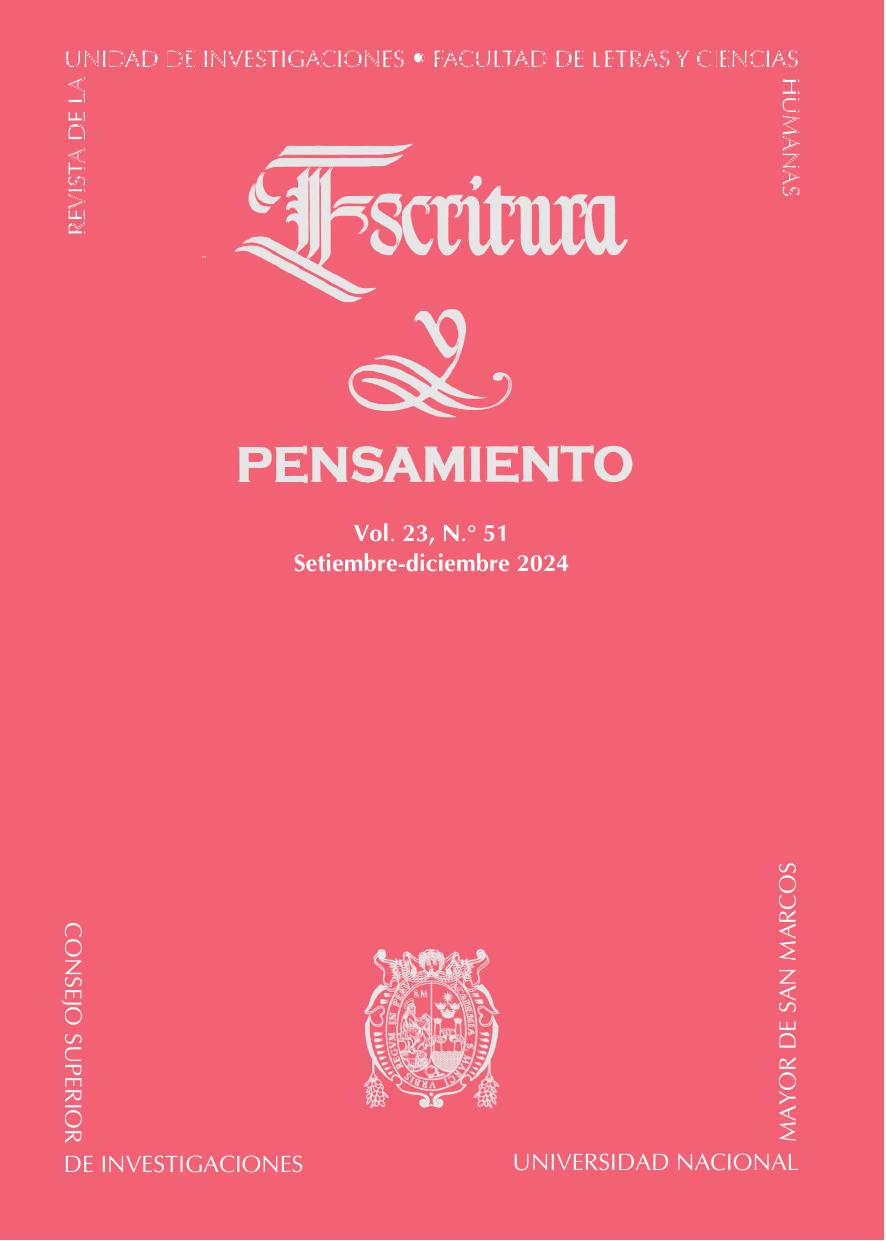Speech on oral tradition and music: figurative system and andean categories in the song “Ay, zorro zorro”
DOI:
https://doi.org/10.15381/escrypensam.v23i51.28213Keywords:
Andean literature, representation, Andean poetry and song, Ay zorro zorro, Andean categoriesAbstract
Oral tradition discourses, such as Andean songs, have not given way to modernity, but rather remain valid under various cultural processes. This article seeks to investigate the figurative system of the song “Ay, fox fox” through notions of “representation” from Cassirer, Albaladejo, Arduini, Lakoff and Johnson. Likewise, we notice how some Andean categories are accommodated in the text (wakcha, cosmic solitude, tikray, yanantin, tinkuy) that demonstrate the cultural consciousness inherited through worldview and cosmolife. We use two old anonymous versions of this song and two others with arrangements performed and popularized by Jacinto Palacios and Pastorita Huaracina.
References
Arduini, S. (2000). Prolegómenos a una teoría general de las figuras. Universidad de Murcia.
Ávila, F. de. (1966). Dioses y hombres de Huarochirí. Traducción de José María Arguedas y estudio bibliográfico de Pierre Duviols. IEP.
Cassirer, E. (1971). Filosofía de las formas simbólicas. Fondo de Cultura Económica.
Choque, R. (2019). Zorro zorro - Pastorita Huaracina. Youtube, subido por Rolando Choque, 14 de setiembre de 2019, https://www.youtube.com/watch?v=8TvA0ZM8M0s
De Llano, A. (1995). Voces y huellas de la oralidad: un encuentro con Martin Lienhard. CELEHIS, 4-5, 293-302.
Espino, G. (2022). Harawinchis. Poesía quechua contemporánea (1904-2021). Pakarina Ediciones.
Estermann, J. (2009). Filosofía andina. Estudio intercultural de la sabiduría autóctona andina. Abya - Yala.
Fajardo, L. (2006). La metáfora como proceso cognitivo. Forma y función, 19, 47-56.
Farfán, J. M. B. (1944). Canto quechuas de Ancash. Revista del Museo Nacional. XVIII, 145-152.
Gonzáles Holguín, D. (1608). Vocabulario de la Lengua General de todo el Perú llamada Lengua Quichua o del Inca. Imprenta de Francisco del Canto.
Husson, J-P. (1993). La poesía quechua prehispánica. Revista de Crítica Literaria Latinoamericana, 19, 63-85.
Husson, J.P. (2002). Literatura quechua. Boletín del Instituto Riva-Agüero, 29, 387-522.
Julca, F. y Nivin, L. (2019). Recursos expresivos y literarios en el huayno. Letras, 90(132), 260-284.
Lakoff, G. y Johnson, M. (2009). Metáforas de la vida cotidiana. Ediciones Cátedra.
Melgarejo Rodríguez, O. (2018). Sintaxis del quechua en el cantar bilingüe huaracino. Tesis de maestría, Universidad Nacional de Educación Enrique Guzmán y Valle.
Ong, W. (1996). Oralidad y escritura. Tecnologías de la palabra. Fondo de Cultura Económica.
Salazar Mejía, L. (2020). Jacinto Palacios Ay zorro, zorro. Youtube, subido por Luis Salazar Mejía, 26 de marzo de 2020, https://www.youtube.com/watch?v=ksz4Zu-ElDI
Oviedo, J. M. 1995). Historia de la Literatura Hispanoamericana. 1. De los orígenes a la Emancipación. Alianza Editorial.
Villafán, M. y Olórtegui, R. (2016). Fórmulas de Metaforización en el quechua ancashino. Revista Académica UNASAM, 3(4), 309-327.
Downloads
Published
Issue
Section
License
Copyright (c) 2024 Alejandro Mautino Guillen

This work is licensed under a Creative Commons Attribution 4.0 International License.
AUTHORS RETAIN THEIR RIGHTS:
a. The authors retain their trademark and patent rights, and also over any process or procedure described in the article.
b. The authors retain the right to share, copy, distribute, execute and publicly communicate the article published in the Escritura y Pensamiento (for example, place it in an institutional repository or publish as part a book), with acknowledgment of its initial publication by Escritura y Pensamiento.
c. Authors retain the right to make a subsequent publication of their work, to use the article or any part of it (for example: a compilation of their work, lecture notes, thesis, or for a book), provided that they indicate the source of publication (authors of the work, journal, volume, number and date).





